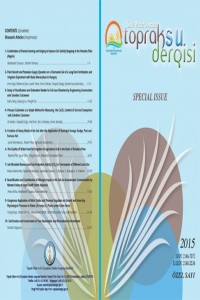Plant growth and potassium supply dynamics on a chernozem soil of a long-term fertilization and irrigation experiment with maize monoculture in Hungary
Öz
For the plant production used soil's nutrient supplying ability ideally should correspond to the needs
of the plants. The aim of our experiment work is to study as precisely as possible, how the dynamics of
growth and nutrient uptake of the maize plant develop during the vegetation period. For their
determination the basis of our research work was a long-term irrigation and fertilization monoculture
maize field experiment that has been set up in 1984 near to Debrecen, Hungary. The soil of this
experiment is a medium-heavy, loam texture calcareous chernozem type based on loess. The deepness
of humus soil layer is between 70 and 90 cm. Its upper layer has become leached due to the intensive
production in the past decades, so it doesn't content any significant lime-amount. Therefore, the soil pH
is slightly acidic in the production layer, which is favorable for nutrient-mobilization and -uptake. This
field represents the production circumstances of the chernozem soils of Hungary with excellent
productivity. Effects of three factors were studied: genotypes of maize (3), fertilizer dosages (6) and
irrigation levels (2). The total number of investigated treatments (plots) was 36. Plant samples were
collected 7 or 6 times during the vegetation period, and the above-ground dry matter and the nutrient
uptake of plants were determined. For characterizing and describing of the plant growth and nutrient
uptake dynamics was used the so-called “S-type” (acceleration – saturation) equation as follows:
y=A/(1+exp(-k*(x-x0)))*(1-b*x), where “y” is the actual value of the measured (dependent) factor on the
day “x” after plant shooting, “A” is the maximum value of “y”, “x0” is the day of maximum growth rate of
“y” (point of inflexion) and “b” is the rate of decreasing of dependent value for one unit. According to
our results and calculations it can be concluded, that beside the previously used soil and plant nutrientcontent
the consideration and calculation of the plant-extracted nutrient-amount – depending on the
applied hybrid and other agro-technological measurements – is suggested in order to characterize
precisely the nutrient-supply of maize. This parameter informs us not only about the available nutrientamount
at the sampling time, but about the supply level of the plants until the sampling time as well.
We suggest for sampling times the intensive vegetative growth period, the switch between the vegetative
and generative growth phases (silking), just as the grain-filling phase.
Anahtar Kelimeler
Plant growth and potassium supply dynamics on a chernozem soil of a long-term fertilization and irrigation experiment with maize monoculture in Hungary
Öz
For the plant production used soil's nutrient supplying ability ideally should correspond to the needs
of the plants. The aim of our experiment work is to study as precisely as possible, how the dynamics of
growth and nutrient uptake of the maize plant develop during the vegetation period. For their
determination the basis of our research work was a long-term irrigation and fertilization monoculture
maize field experiment that has been set up in 1984 near to Debrecen, Hungary. The soil of this
experiment is a medium-heavy, loam texture calcareous chernozem type based on loess. The deepness
of humus soil layer is between 70 and 90 cm. Its upper layer has become leached due to the intensive
production in the past decades, so it doesn't content any significant lime-amount. Therefore, the soil pH
is slightly acidic in the production layer, which is favorable for nutrient-mobilization and -uptake. This
field represents the production circumstances of the chernozem soils of Hungary with excellent
productivity. Effects of three factors were studied: genotypes of maize (3), fertilizer dosages (6) and
irrigation levels (2). The total number of investigated treatments (plots) was 36. Plant samples were
collected 7 or 6 times during the vegetation period, and the above-ground dry matter and the nutrient
uptake of plants were determined. For characterizing and describing of the plant growth and nutrient
uptake dynamics was used the so-called “S-type” (acceleration – saturation) equation as follows:
y=A/(1+exp(-k*(x-x0)))*(1-b*x), where “y” is the actual value of the measured (dependent) factor on the
day “x” after plant shooting, “A” is the maximum value of “y”, “x0” is the day of maximum growth rate of
“y” (point of inflexion) and “b” is the rate of decreasing of dependent value for one unit. According to
our results and calculations it can be concluded, that beside the previously used soil and plant nutrientcontent
the consideration and calculation of the plant-extracted nutrient-amount – depending on the
applied hybrid and other agro-technological measurements – is suggested in order to characterize
precisely the nutrient-supply of maize. This parameter informs us not only about the available nutrientamount
at the sampling time, but about the supply level of the plants until the sampling time as well.
We suggest for sampling times the intensive vegetative growth period, the switch between the vegetative
and generative growth phases (silking), just as the grain-filling phase.
Anahtar Kelimeler
Ayrıntılar
| Birincil Dil | İngilizce |
|---|---|
| Bölüm | Makaleler |
| Yazarlar | |
| Yayımlanma Tarihi | 31 Ocak 2015 |
| Yayımlandığı Sayı | Yıl 2015 Özel Sayı |
Kaynak Göster
Grafik Tasarım : Filiz ERYILMAZ
Basım Yeri : Gıda Tarım ve Hayvancılık Bakanlığı - Eğitim Yayım ve Yayınlar Dairesi Başkanlığı
İvedik Caddesi Bankacılar Sokak No : 10 Yenimahalle, Ankara Türkiye


